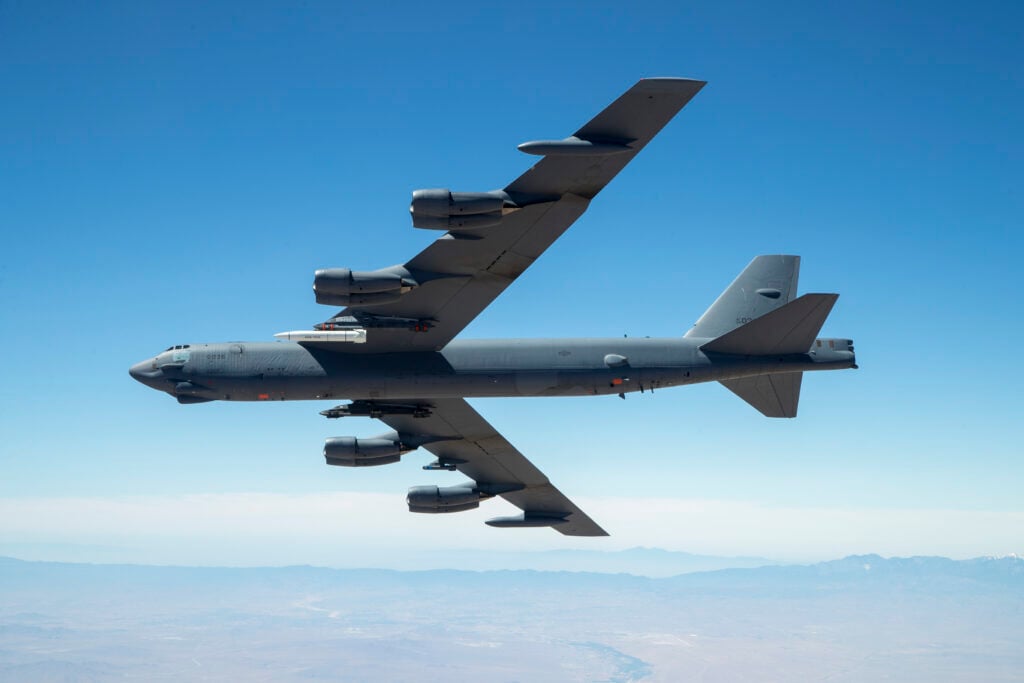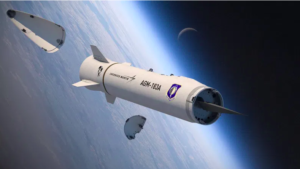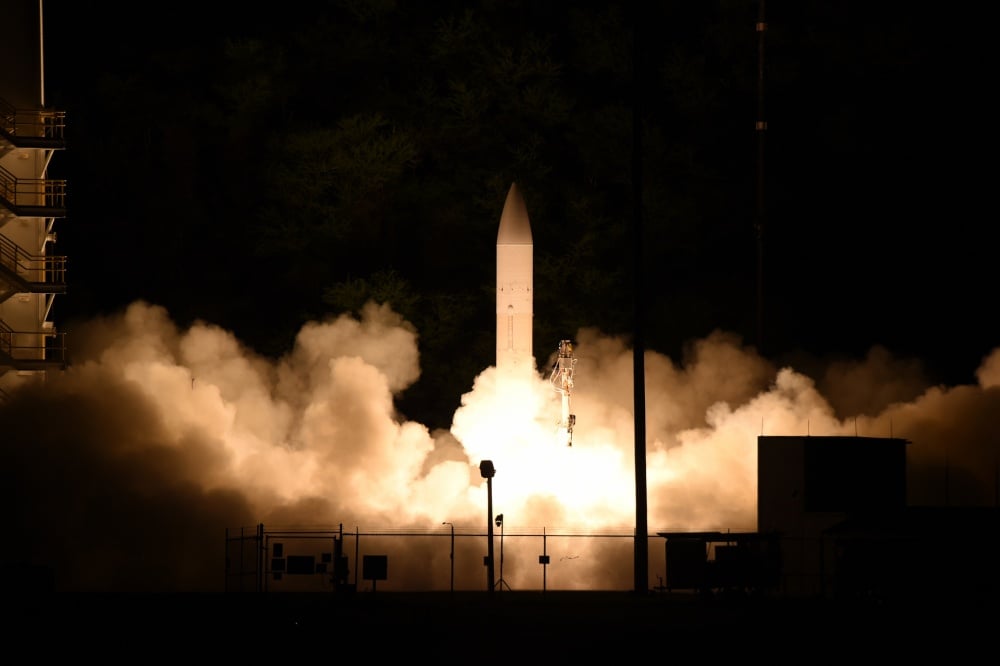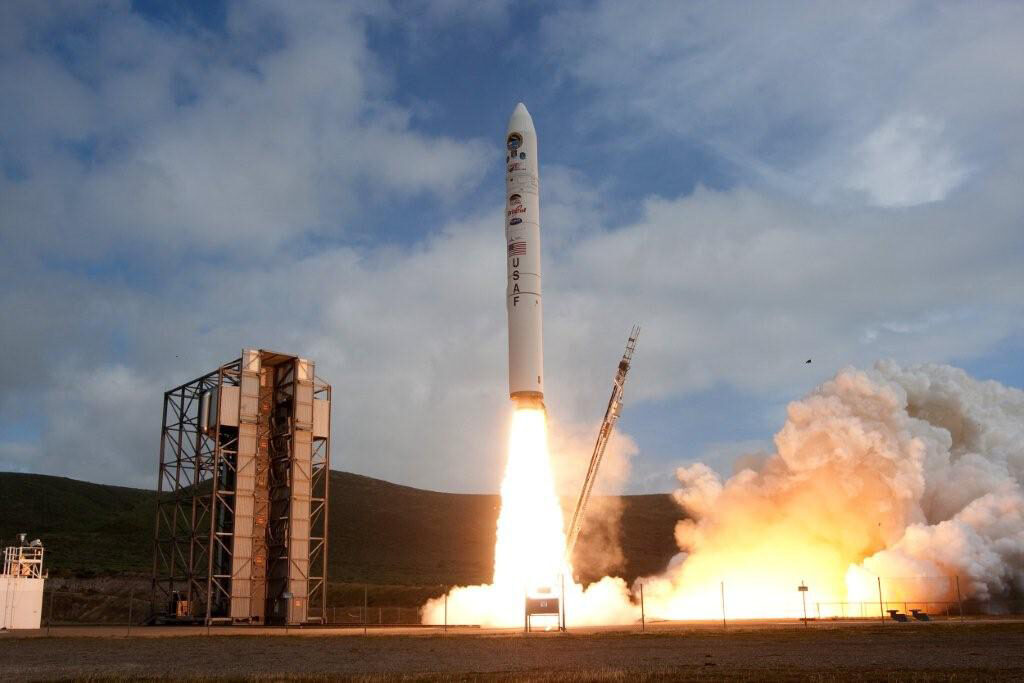
A B-52 bomber carrying the ARRW.
WASHINGTON: The hypersonic Air-Launched Rapid Response Weapon (ARRW) will conduct its first booster test this week, a landmark for the Air Force — but the Pentagon’s hypersonics R&D director sounded two notes of caution.
First, Michael White warned, future tests must not be marred by sloppy mistakes: “If [for example], we forgot how to do a checklist and tighten a pin on a fin, and we lose a flight vehicle because our fin falls off, that’s not acceptable failure. …. Quite frankly, we’ve got a ways to go. I’m not going to be satisfied with the health of the industrial base until we are routinely, successfully flying hypersonic weapons in our prototype development program. And so far we haven’t been able to do that routinely.”

AGM-183A Air-launched Rapid Response Weapon (ARRW) (Lockheed Martin graphic)
Second, White said, while “boost-glide” hypersonics weapons like ARRW will become operational first, smaller and cheaper “air-breathing” hypersonic cruise missiles are “probably the most significant” contribution the Air Force will make. “The hypersonic cruise missile is, in my mind, a game changer,” he told the Air Force Association’s online Aerospace Warfare Symposium.
Maj. Gen. Andrew Gebara, director of plans at Air Force Global Strike Command, agreed. “ARRW … it’s available, it’s good capability, it’s quick,” Gebara said, speaking at AFA alongside White. “We’ll [be] buying capability by the end of ’22….that will actually be provided to the combatant commanders, if necessary.
“[But] we also want to get to that cruise missile capability,” he said, referring to the more compact Hypersonic Attack Cruise Missile (HACM). “I can put four ARRWs on a bomber….I could put 20 HACMs on a bomber if done right – and maybe more.”

Launch of Army-Navy Common-Hypersonic Glide Body (C-HGB) in Hawaii on March 19, 2020.
Boost-Glide vs Air-Breathing
What’s the big difference among types of hypersonic weapons? In short, it’s size. For a given size of warhead, boost-glide weapons are bigger and more expensive – and also faster.
A boost-glide hypersonic weapon, as the name implies, launches on a rocket booster, very much like an ICBM, which gets it up to near Mach 20. Then the “glide vehicle” containing the warhead detaches and coasts, like a glider, through the upper atmosphere. While the glide vehicle has no engine to generate more thrust, it can maneuver far more nimbly than a conventional ballistic missile, potentially allowing it to bypass missile defenses.

Raytheon concept for an air-breathing hypersonic cruise missile image
An air-breathing hypersonic cruise missile, by contrast, is a much smaller weapon that flies through the atmosphere like a jet – specifically, it’s a high-speed variant called a scramjet – under continuous power, making it even more maneuverable than a boost-glider. The air-breather also has to fly lower, where the air is thicker: That limits maximum speed – probably well under Mach 10 – but it means the atmosphere provides all the oxygen the engine needs to burn its fuel.
By contrast, a boost-glide weapon has to carry its own fuel plus the oxidizer to burn the fuel, which is why it has to be a lot bigger to carry the same size payload.
Size constraints matter a lot less for Army ground-based launchers or Navy warships, which is why those two services are collaborating on a Common Hypersonic Glide Body. But size is a major limiting factor for a strategic bomber, let alone a tactical fighter, so the Air Force is especially interested in air-breathing cruise missiles.
Conversely, air-breathers are better suited for launch from aircraft than from surface vehicles, since an air-breather’s scramjet engine has to be moving at supersonic speed to start working. You can launch scramjets from the ground or a subsonic aircraft, but you need a booster rocket to get them up to speed. The lower and slower you are when you launch, the bigger, more powerful, and more expensive that booster needs to be – which erodes the size and cost advantages that make air-breathers attractive in the first place.
A subsonic bomber like a B-52 can launch air-breathing hypersonics with a modest booster, making it a practical option for the HACM, as Air Force Global Strike Command has said. But you could also develop air-breathers compact enough to carry on the military’s vast inventory of fourth-generation fighters like the Air Force F-15 and F-16 (or the Navy F-18), as well the 5th-gen F-22 and F-35.
“The Air Force brings, I think, a unique attribute to the fight, and that is being able to bring hypersonics to fight in numbers,” White said. “So we are really, really looking forward to getting the air-breather into the stage of weapon system prototyping and fielding.”

DARPA’s experimental hypersonic boost-glide vehicle, HTV-2, is launched for a flight test in 2010
Proceed With Caution
As eager as White is to get more hypersonics into testing, he wants it done rigorously and carefully so hasty mistakes don’t end up costing time. Yes, it’s important and necessary to take risks when exploring new technology, he said. There’s a value in the Silicon Valley ethos of “fail fast” – but you want your failures to be learning experiences, not reminders of obvious basics you forgot.
“We’re learning the wrong stuff; we’re learning that we lacked the experience and competence to do it right from a systems engineering perspective,” White lamented. “In order to go fast, we need to do it right the first time.”

Michael White
That’s hard because US hypersonics works has largely been done by research labs, whose focus is on innovation rather than reliability. Private-sector manufacturing firms, which focus on building the same thing so it works the same way every time, are in the early stages of entering the hypersonics business.
“We have… a laboratory-based community in hypersonics, not a community that knows how to build weapons and implement rigorous systems engineering to develop concepts and get a successful flight test,” White said bluntly. “Industry needs to step up with the best and brightest systems engineers they’ve got to get us over the hump to develop weapon systems.”
In a ‘world first,’ DARPA project demonstrates AI dogfighting in real jet
“The potential for machine learning in aviation, whether military or civil, is enormous,” said Air Force Col. James Valpiani. “And these fundamental questions of how do we do it, how do we do it safely, how do we train them, are the questions that we are trying to get after.”


























